Mullan Emigrants to Australia & NZ, of Dungannon, Co. Tyrone
mskp[at]xtra.co.nz
Robert Mullan of Dungannon abt 1808-1866
Records of his birth and marriage have not been found, although we know his wife’s name was Maria Handcock (or Hancock) from the marriage and death records of his sons. Their marriage licence from 1836 is indexed at the Public Record Office in Dublin. Marriage by licence involved payment of a fee and was commonly chosen in preference to marriage by bans as a statement of status. So although in his later life we find Robert occupied as a jailer and small farmer, there is a hint in this record that his origins may have been rather more affluent.
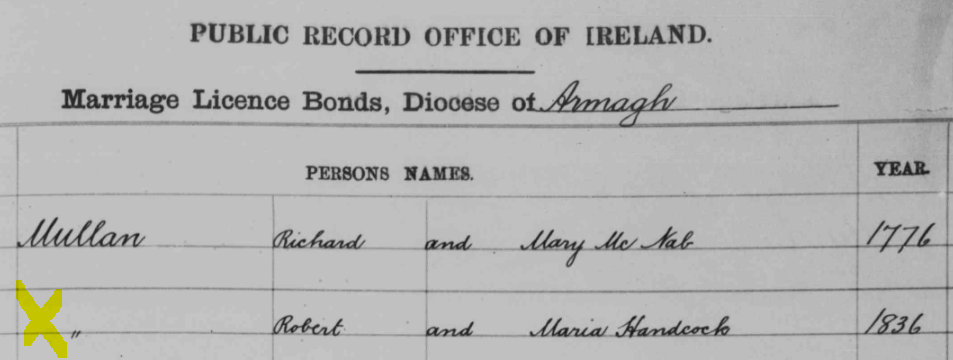
Robert died at Dungannon in 1866 aged 58, his occupation having been described in various family documents as farmer, police sergeant, gaol manager and bridewell keeper. I have tried to make sense of these different occupations, and suggest that when farming failed to yield an adequate income he added the position of bridewell keeper which would also provide a pension for his widow.
Robert the farmer
In the 1841 election Robert Mullan, 42 Scotch St, baker, voted for Lord Northland in Dungannon electorate. This address may be one of the properties mentioned in his will (see below). In 1841 he was married with two young children and here we find him working as a baker, but shortly he would take up farming. The fact that he voted tells us that he occupied property worth at least ten pounds per annum.
In the period 1845-55 Robert’s name appears repeatedly in newspaper reports of Dungannon Agricultural Society fairs, winning prizes for cattle and pigs. Competition was arranged in two classes – gentlemen and farmers, Robert being among the latter. During the progress of the 1850 show a digging match took place in a field near the town, belonging to Mr Robert Mullan, and on that occasion the show judges also visited his crop of turnips, grown after vetches, and considered it most creditable.9
Agricultural Societies were active all over Britain at the time, promoting improvements in agricultural practice, and concern about harvest failures was giving impetus to the search for better farming outcomes. In spite of their best efforts, however, Robert did not see a future in farming for his four sons.
A clue to the farm’s location was provided in an 1859 court case by a witness who had been "returning into Dungannon from Edendork, when passing Mr Robert Mullan's gate at the end of the wall of Mr Quain's plantation ......." 9 Turning to Griffiths Valuation 1860 20 we find that the Rector, Rev William Quain, was leasing seven acres of the Killylack Glebe to Robert “Mullin”. Close by, in the townland of Lurgaboy, Robert was leasing a further 8 acres from the Earl of Ranfurly. Such small land-holdings were quite usual at this time. The two parcels had a combined annual value of £16, although neither parcel included a house. The map following shows the position of this land, approximately two kilometres from the courthouse where the family had their accommodation (see below).
The whole area, including the town of Dungannon, was included within the parish of Drumglass. More detail about the area is available from the Ordinance Survey Memoirs for Tyrone 15


Map of Drumcoo townland in parish of Drumglass, Co Tyrone (source Griffiths Valuations 20)
Son Thomas indicated in his retirement interview [Manawatu Standard 29 Aug 1908] that he had been raised on the Earl of Ranfurly’s estate and it is possible that more could be learned about their tenancy from estate papers available at PRONI and also on microfilm from FamilySearch.org.13, 14
The family should have felt right at home when their former landlord followed them to New Zealand, in the person of the 5th Earl of Ranfurly, who held the post of Governor from 1897-1904. He is remembered as the donor of the Ranfurly Shield, still regarded by many as NZ’s premier rugby award.
Robert the bridewell keeper
A bridewell keeper was the manager of the local gaol, an institution for petty criminals as distinct from prisons which housed more serious felons. An idea of the scope of his responsibilities may be gathered from the following: [Source: Samuel Lewis' Topographical Dictionary of Ireland, 1840]
The [Dungannon] court-house is a spacious and handsome building, erected in 1830; under it is the bridewell, containing a day-room and four large cells for male prisoners, with a yard, day-room, and cells for female prisoners; the same accommodation for debtors, and apartments for the keeper.
The image below (Google Streetview 2010) shows the Old Courthouse as a somewhat derelict building with vegetation growing on the roof, but the layout with basement rooms is evident. GPS Location 54° 30′ 13.34″ N, 6° 46′ 27.79″ W, on the west side of Georges St, between William St and Ann St (renamed Fairmont Park). Old maps show the Courthouse facing straight down Georges St before the latter’s realignment and extension through to Ann St.

A glimpse of Robert’s civic duties is provided in an account of the St Patrick’s Day celebrations in 1850. The authorities, to avert any possibility of civil disturbance, had despatched a military troop to Dungannon. The locals however, considering such a precaution quite unnecessary, decided that some public entertainment was needed to occupy the troops. Accordingly, Mr Mullan at the court-house was asked to arrange “a large supply of bats and balls, wickets, footballs, cards, marbles, kites, etc. for the amusement of the troops.” [Morning Post, 21 Mar 1850 9]
The bridewell keeper’s task was not all fun and games however as the Belfast Morning Post reported on 3 March 1862: 9
ATTEMPT TO MURDER THE BRIDEWELL-KEEPER OF DUNGANNON
Dungannon Saturday morning
This morning a murderous attack was made on Mr. Robert Mullan, bridewell keeper of this town, when paying the usual morning visit to the cells where prisoners are confined. This attack, which would show some premeditation, was made by one of the three prisoners at present in bridewell awaiting adjudication by the magistrates on next petty sessions day. One of these had been arrested for vagrancy in the town of Moy. He is well known about the country. He has an idiotic and repulsive expression of countenance. He went about the streets beating an imitation of the tambourine, and accompanying the performance by a species of drone. He generally wore left-off policeman’s clothes, and a ribbon tied round his head. It was he who committed this murderous assault on Mr Mullan. The attack was so unexpected and so fearful that Mr Mullan was nearly overcome; but though he was struck several times over the head with a heavy pair of iron tongs, and was bleeding profusely, he struggled desperately and managed to wrest the tongs from the prisoner’s hands. The prisoner then sought to strangle Mr Mullan. He tripped him up, throwing him on the ground, and was attempting to regain the tongs while he was also endeavouring to choke him - Mr Mullan succeeded in calling out murder and he begged of the two other prisoners to save his life.
Mrs Mullan, noticing the unusual time he was in the cells, went in that direction, and, fortunately, hearing the cries, also rushed to the door. There she saw, through the bars, her husband lying in the monster’s gripe, covered with blood; but between her and them was the iron door, locked in the inside! And the key in Mr Mullan’s possession. A terrible moment of agony this was to her; yet her presence of mind did not desert her. She remembered she had a duplicate key, and she soon procured it. Mr John Wright had been passing. He came to her assistance, and by their joint exertions, Mr Mullan was relieved from the almost certainty of being murdered.
On examination it was found that the wounds inflicted, though very serious, are not of such a character as to warrant fears for Mr Mullan’s life; but, had Mrs Mullan and Mr Wright not arrived at the opportune moment, it is feared the attack would have proved fatal. It would seem that the two other prisoners had entered into an agreement not to assist Mr Mullan; and under these circumstances they are equally guilty of cold-blooded villainy as the assailant himself.
Mr. Mullan has long filled his present situation, and, though it is one which is said not to draw in the most tender feelings, in his case the aphorism does not apply, for he is proverbial for good nature and kindness, even to those whose faults, misfortunes, or even crimes, have brought them into contact with him.
Next week, at the Crown Court, Patrick Rooney aged 50 was convicted of the assault and sentenced to 3 months hard labour, the jury having found him to be insane.
Turning to the mention of
“police sergeant” by one of the sons for his father’s occupation, the
name Robert Mullan is included in a published list of members of the
Royal Irish Constabulary.17
However, this record proved to relate to a much younger man, born in
Londonderry about 1835 which rules him out as our ancestor. My guess is
that “police sergeant” was a confusion with or perhaps a euphemism for
“gaoler”.
The full text of Robert’s will is included as
Appendix 1 of this document. From it we learn that Robert held leases on
three properties, two in Scotch St, Dungannon (to be shared by sons
Thomas and George) and one in Coalisland (bequeathed to son Robert). The
probate calendar indicates a total value of £450 which was to be used to
pay off his debts and mortgages, to finance George’s emigration, to
augment his widow’s pension from the prisons service to £30 p.a., and
then be divided among his three daughters. Should the daughter’s
portions amount to less than £100 each, their legacies were to be topped
up with income from the property left to their brothers.
Noted in passing – may refer to the same property as is mentioned in the will:
PRONI D4183/6/1 Date 1705 Lease from Thomas Knox of Dungannon to James Mullan of Derrygortrevy, Co. Tyrone, for a tenement in Scotch Street, Dungannon, paying annual rent of £1 17s
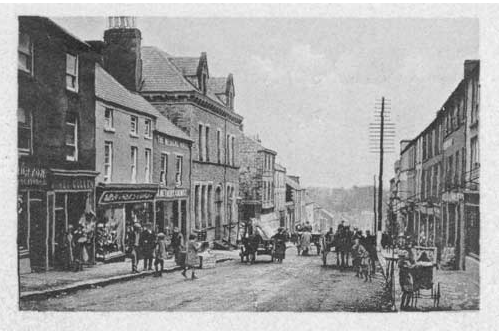
Scotch Street, Dungannon as Robert Mullan would have known it. [image cotyrone.com]
The two leasehold properties in Scotch Street can be found in Griffiths Valuation 1860: 20
Occupier: James Cochrane Immediate Lessor: Robert Mullan
Location: (Map Ref 60 no 35) Scotch St, Townland Drumcoo, Parish Drumglass, Union Dungannon
Description: House, Office, Yard and small garden - annual rateable value £16.0.0
Occupier: William Guiney Immediate Lessor: Robert Mullan
Location: (Map Ref 60 no 36) Scotch St, Townland Drumcoo, Parish Drumglass, Union Dungannon
Description: House, Offices, Yard - annual rateable value £24.0.0
I have not found Robert Mullan as either landlord or tenant in Griffiths valuation for Coalisland and it appears that he acquired that lease some time between 1860 and his death in 1866.
Robert Mullan is not named as the occupier of any property in Dungannon Griffiths Valuation. His residence at the bridewell in George’s Street (Parish Drumglass) is listed as follows:
“Occupier: Sessions House, bridewell, yards and garden. Immediate Lessor: (see exemptions)”
Neither does Robert Mullan’s name appear in the Tithe Applotment book for Drumglass parish 1832 as might have been expected.21 I think the reason for this was that 1832 was too early for him to have his own household. The eldest of his 7 children was born in 1837 and he probably married a year or so before that. It is worth noting that a James Mullan is listed in the Tithe Applotments for Drumglass, residing at Dungannon Gardens in the townland of Drumcoo. Robert named his eldest son William James, supporting the possibility that this James Mullan was Robert’s father.
1835-36 Valuation Office books record:
Scotch Street Dungannon – John Mullan 14.0.0 [amount of houses one-third having been deducted]
Scotch Street Dungannon – James Mullan 18.0.0 [amount of houses one-third having been deducted]
Georges Street Dungannon – James Mullan 6.6.0 [amount of houses one-third having been deducted]
Authorities identify Mullan as an ancient Irish surname of Gaelic origins, formerly O’Mullan (with other variant spellings). However, there are also Mullans in the north whose surname derives from the Scottish MacMullen or MacMillan, borne by many 17th century Scottish settlers. The religion (Church of Ireland) of the present family may be in favour of a Scottish origin.
Robert’s sons
William James Mullan 1837-1867
William, the eldest son, received no legacy in his father’s will, where it was explained that his share was represented by the expense that had been put into his education and establishment in a career, but what career? The Tyrone Constitution 16 October 1857 provided the explanation: “William James Mullan, Esq., of the Royal College of Surgeons, Dublin, and son of Mr Robert Mullan, Dungannon, having passed his examination before the Army Medical Board, London, on the 12th ult. was appointed assistant surgeon of Her Majesty’s 81st Regiment now in Bengal, India.”
His brief career is summarised in A Directory of Ulster Doctors16 kindly supplied by the archivist at RCSI.

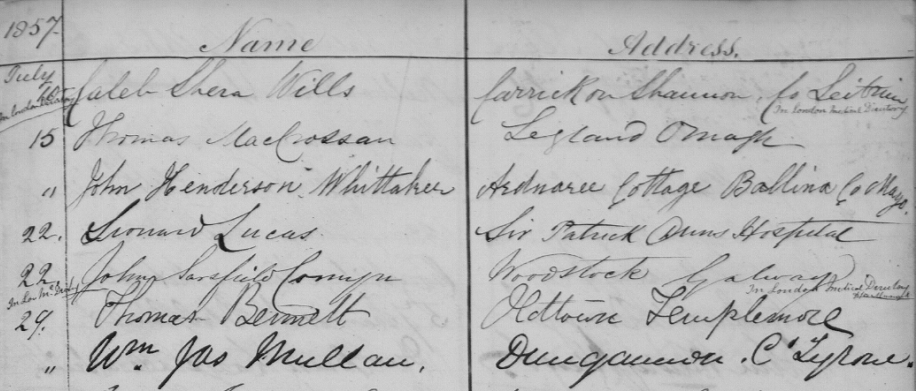
Signature from roll of Royal College of Surgeons Licentiates 29 July 1857
As no wife or children were mentioned in his death notice it is assumed that he was unmarried. No probate record found.

Thomas Mullan 1839 – 1918
Thomas has written an account of his life for the Cyclopedia of NZ in 1905 2, which is reproduced here as Appendix 2. It is likely to be reasonably accurate, although fading memory may have confused some details, for example, the date of his marriage. He emigrated to Australia about 1853, at the age of 14, most likely in the company of a relative or family friend, or at least carrying letters of recommendation. It is likely that he sent back optimistic reports which underpinned his father’s encouragement for the next brother George to emigrate in his turn. Although following the gold rushes to Victoria, Australia, then Otago, and finally the West Coast of New Zealand, Thomas found opportunities in infrastructure development rather than in working a mining claim himself. He was a boatman in Westport as early as 1874 when he had a brief skirmish in the bankruptcy court. His career took him from working on road and railway developments to taking charge of significant projects, including bridge building. He eventually became Inspector of Permanent Way for the Wellington and Manawatu Railway company, responsible for the Maintenance Department and a staff of 140.22 He retired to Auckland when the company was bought out by the Government about 1908.
He married Mary Fitzgerald from Melbourne, daughter of George Fitzgerald and Catherine, nee Keegan, in Westport Registry Office on 24 August 1881, brother Robert being a witness. They had two daughters and two sons (refer chart), but as there were no male line grandsons, the Mullan surname is extinct among Thomas’ descendants.
He died at his home at 44 Wanganui Avenue, Ponsonby, Auckland on 11 Jan 1918 and was buried at Purewa Cemetery with his wife, younger son and daughter-in-law and their infant daughter. His widow petitioned parliament – “Praying for compassionate allowance for services of her late husband in the Railway Department,” receiving this in reply “I am directed to report that the Committee has no recommendation to make. 28th September, 1920.” [refer A to Js] 8
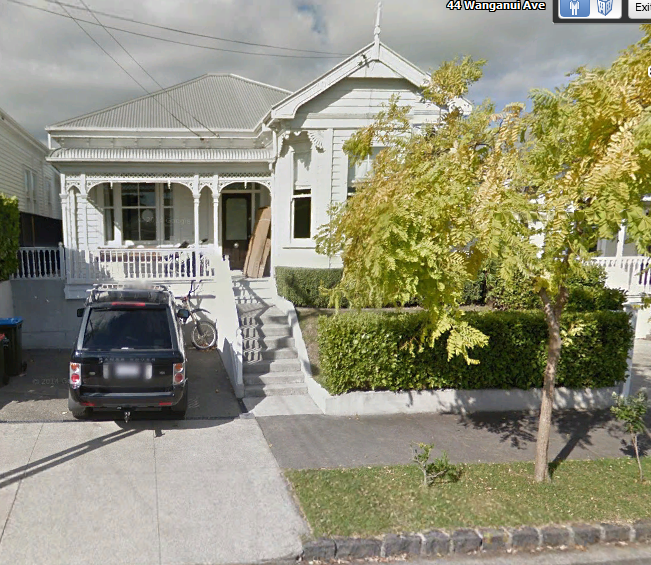
44 Wanganui
Avenue Ponsonby in 2015. Assuming the street has not been renumbered,
this would have been the Auckland home of Thomas and Mary Mullan.
(image Google Streetview)
George Mullan 1843 - 1899
In his father’s will special attention is given to making funds available for George’s emigration either to America or Australia. His two older brothers had already left home and the best prospect Robert could see for his third son rested in the colonies, advice that was duly followed.
The Westport Times 15 May 1883 reported: Mr R. F. Mullan, County Clerk, has shown us a letter received from his brother George, who is now located at Herberton, Wild River, North Queensland, and from which we are permitted to extract some interesting information. Mr Mullan was for some time in New South Wales, but was prevented from settling there mainly through the mining laws in force in that Colony, which allow parties to hold ground for years without doing any labor upon it. He then went to the place where his letter is dated from (Herberton), and this is what he says about the country: “This place will, in the course of years, be one of the richest in the Southern Hemisphere. Some of the tin lodes are very rich, and I believe when machinery to any extent arrives here there will be work for thousands of men—the field is so extensive, taking in a radius of over 30 miles. The climate cannot be equalled in any part of Australia. It is as cold, if not colder, than any part of the West Coast, of New Zealand. I expect you will hardly believe me in fact I would not believe it myself, and came here with light clothes, and was nearly perished with cold—and that near Christmas. Not only the tin, silver, copper, nickel, and antimony will make this place flourish, but there is splendid land and cedar scrubs for miles between here and the coast, which are a mine of wealth in themselves, or will be when the country gets opened up. Port Douglass is 80 miles from Herberton, with splendid land the greater portion of the way, and running creeks of good water. Cairns is 50 miles from here, with grand sugar land and cedar scrubs the whole way. There is another route, which I believe will shortly be opened, and which I believe will open up a large extent of mineral and cedar land. As soon as a railway is made here this will become a flourishing place. Wages are from £3 10s to £4 10s, but at present things are dull, as this is the wet season, and work is knocked off until it is over. I have got a sluicing claim - it is not up to much at present, but I expect it to turn out good wages before long."
A little more of George’s movements can be gained from his death certificate (Appendix 3). In answer to the question “How long in the colony/state” the answer given is “1yr NZ, 3yrs Queensland, 30 yrs NSW.” This information was provided by the superintendent of the asylum at Liverpool, NSW, where George died of cancer of the rectum, on 24 Jun 1899 aged 56. The date and age place him as the third son, which agrees with the impression given in his father’s will. He is likely to have emigrated soon after his father’s death in 1866, so the estimate of years in the colonies is quite believable. The 1 yr in NZ appears to have been spent with Thomas and Robert on the West Coast. The 1881 electoral roll for Buller lists George Mullan, Buller Road, contractor, and in the same electorate Robert F Mullan, Cobden St Westport, contractor, as well as Thomas Mullan, Westport, contractor.
The death certificate indicates that George never married, occupation miner.
Robert Francis Mullan snr 1847-1928

Robert Francis Mullan 1902 County Clerk, Buller County Council. (image courtesy KeteWestCoast website)
Robert was the fourth and youngest son, still under age when his father died in 1866. He would eventually follow his older brothers to Australia and New Zealand, but may have been obligated to remain near his mother during her widowhood.
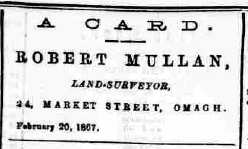
Could this card belong to “our” Robert Francis Mullan? The advertisement began to appear in the Tyrone Constitution shortly after his father’s death. By modern standards he was young to be setting out in business on his own, but the loss of the family breadwinner may have precipitated a move. A James Mullan who operated a coal business from the same address, may have been a cousin. Omagh was the nearest larger town to Dungannon.
According to his obituary he came to Queensland in 1867 and to NZ in 1870. He worked in various mining and road construction capacities around Westport throughout the 70s but seems to have gravitated towards clerical work. In 1873 he was elected to the Board administering The Goldfields Local Revenues Act in the Buller region, and in 1874 he was secretary of the All Nations Quartz Mining Company (No. 2 North), Mohikinui. In 1878 he tendered unsuccessfully to do property valuations for the Buller County Council. About 1881 he may have been contracting in partnership with Thomas and George.
From 1881-1913 he was secretary to the Buller Hospital and Charitable Aid Board, retiring on twelve months' full pay after 32 years’ service.
In 1883 the Buller County Council suspended their clerk Mr Dempsey citing a deficiency of funds and Mr R F Mullan was appointed acting clerk in his place while the position was advertised at a salary of £156 per year. After serving as Buller County Clerk for 27 years Robert resigned in 1909 owing to advancing years and failing health and was awarded a retiring allowance of six months' full pay. His third son John Robinson Mullan took over as County Clerk-Treasurer on 18 Jan 1910.
Robert was instrumental in forming the Westport Building Society and served as its secretary from 1883-1927.
The Westport Times reported Mr. R.F. Mullan travelling on the Frances Gertrude to Melbourne from Westport on 11 Aug 1876. He would have been on his way to Sydney, where, on 28 Sep 1876 he married Elizabeth Anne Robinson at St Peter’s Anglican Church, giving his occupation as “clerk”. Eliza’s eldest brother James was a witness. Their father, John Robinson, a tinsmith, was also from Dungannon, so the families may have been acquainted before their emigration. The Robinsons had come to Auckland in 1866, but moved on to Sydney shortly afterwards (refer my Robinson paper 19).
Molly Mullan said that Robert and Eliza came straight to Westport by ship. Eliza was left on the wharf with the luggage while Robert went to find accommodation. She was there all one very wet, cold day, a seasick bride of 21 - not a happy introduction to her new country. Her name was given as Lizzie in the birth registrations of their five children, but in later life she was known as Eliza.
On 6 May 1884 the Westport Times reported: A very noticeable addition to the continually increasing number of first-class private dwellings in Westport is the new residence of Mr R. F. Mullan, at the corner of Pakington and Russell streets. The dimensions of the main building are 20ft. x 34ft., with a lean-to at the back running the whole length, 12ft. deep, and a verandah facing Russell street ornamented with neat scroll work. The cottage proper contains six rooms, those in front 14 x 14 and the others 12 x 14, and the passage is 6ft. wide. The cottage has fronts to both streets. It is built in a style which has become very popular in Westport of late. The cost, we learn, was under £350. The building was erected by Messrs McAphee and Hagedorn, and their work has given the highest degree of satisfaction to Mr Mullan. The Mullans also built a number of rental properties intended to provide for their retirement.
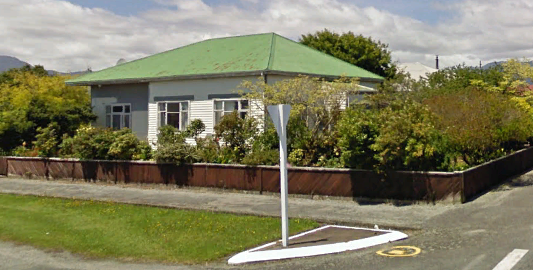
Former home of R F Mullan snr, cnr Pakington and Russell Sts Westport.
Their granddaughter Joan
has written: “The properties were in Eliza’s name, and Robert left a
letter instructing Eliza how to leave her estate.” Joan felt that Eliza
was much less educated than Robert - she doubted if Eliza was literate*,
being unable to remember ever seeing her read or write, but often being
read to. Leaving the property in Eliza’s name proved very unsatisfactory
because so much was to happen after Robert’s death, particularly the
Murchison earthquake and the slump. She was not equipped to cope with business matters and her problems were legion, leaving her at the mercy
of lawyers and accountants. [*Joan may have been somewhat hasty in her
assessment of Eliza’s literacy, judging by this signature from her will
- detailed in my Robinson paper.19]
business matters and her problems were legion, leaving her at the mercy
of lawyers and accountants. [*Joan may have been somewhat hasty in her
assessment of Eliza’s literacy, judging by this signature from her will
- detailed in my Robinson paper.19]
Robert was remembered by Joan as a nice old chap, though very hen-pecked. He was practically stone-deaf in later life so that any communication with him was difficult. Nevertheless he was intelligent in financial matters and was reputed to hear what he wanted to hear.
Eliza was a short rather plump, prim little person, but extremely shy, and difficult to make conversation with. She always wore black, with a little bit of white lace showing at the neck. She went to church in a Queen Alexandra hat with ostrich plumes over the crown. She was a keen worker for St John’s Anglican Church and left them the residue of her estate. They were both Irish Protestant and very anti-catholic.
Molly had more to do with her than any other grandchild because Molly’s mother was a very notorious person. She dumped Molly there every week when she played golf and was involved with boy-friends etc. It was embarrassing to the old people. But Molly was a strange and very lonely child and the old lady became attached to her.
Their home was formidable. Only two rooms were ever used, the kitchen and their bedroom. The rest were meticulously cleaned and dusted but never used. They had a large dining room with many ornaments, mostly tinkly glass vases, glass domes covering birds, flowers, clocks, a few Dresden china ornaments. There was a dining table that served no crumb of food, a fireplace that never burned a stick, leather balloon back dining chairs with shiny slippery seats, and a piano that was never played. Up at the front of the house was another holy of holies that was rarely entered. It was a sitting room furnished mostly in Japanese style, with wicker chairs, matting, and a fine tea set. The bedrooms all had starched lace curtains and crochet bedspreads. The iron bedsteads had canopies and starched side curtains. The kitchen was homely enough, the coal range polished to a mirror finish, the table, benches and kitchen chairs scrubbed snow white. This is where they sat every evening of their lives. He would read the paper to her while she did her crochet work. They were so pleased if their daughter-in-law and granddaughter (Madge and Joan) popped in to see them.
After Robert’s death in 1928 at the age of 80, Eliza (73) was completely lost. She became afraid to sleep in the house alone and Madge discovered that she was not going to bed, just sitting all night at the kitchen table. So she was persuaded to at least sleep at Madge’s house, though she would not live there. Every night at dusk she would arrive, and slip out at daybreak. It was here she found an unexpected joy. This was to sit by an open fire in an easy chair while the other grandmother read Dickens to her. She did love Dickens, and she relaxed more than ever before in her life. It never seemed to occur to her that all those years she herself could have had an open fire and an easy chair. About this time she was also befriended by the nuns at the convent, and enjoyed their company in spite of her late husband’s fiercely anti-catholic sentiments.
In 1929 came the terrible Murchison earthquake. All her property suffered grievous damage, especially bad was the two storied Alexandra Buildings, built of concrete about 1911 before much was known about reinforcing. It was cracked from top to bottom and money had to be borrowed for repairs. It should never have been repaired, and was condemned after the Inangahua earthquake in 1967. There was not a chimney standing in Westport after the Murchison earthquake.
On top of all this worry came the 1929-33 slump. Rents were hard to collect, taxes and rates were high. She became so confused she was making a new will about once a month at one stage. She did leave Madge her chattels. It is a pity Don and Joan had so little time to deal with things at the time of Madge’s death in 1937. They made a huge bonfire of all Grandpa Mullan’s records. He had kept everything. Mary was present as a toddler and “helped” by throwing onto the fire a stack of papers they had set aside to be saved!”
Eliza died in 1933 aged 79, they are buried in the Orowaiti Middle Cemetery at Westport. Refer to chart, and to following section for details of their children.
Robert’s daughters
Matilda Maud ROSBOROUGH, nee Matilda Maria MULLAN about 1845 – after 1925
Matilda’s baptism has not been found, so her birth year is estimated from later documents. Her marriage occurred not long before her father’s death, and his will had not been updated to include her married surname.
In September 1865 several Irish newspapers carried the announcement of the marriage at Rutland Square church, on the 14th inst, by the Rev Dr Hall, Mr John Rosborough of 14 Capel St Dublin and Matilda Maria Mullan, eldest daughter of Mr Robert Mullan of Dungannon. The second name Maria, her mother’s name, is what might be expected for the eldest daughter, but other records name her as Matilda Maud Rosborough. (It was not uncommon at this period for people to change their names informally.)
Two sons and two daughters were born to John and Matilda:
John Adams Rosborough was born on 24 July 1866 in Dublin, and still unmarried in 1920, living with his widowed mother in New York. Various census entries show his occupation as a book keeper, or an insurance collector.
Robert James Rosborough was born on 29 Nov 1867 in Dublin. He emigrated to New York with his parents and brother about 1869, but by 1880 was a schoolboy living with an uncle and aunt Robert and Rebecca Adams. On 25 Oct 1899 he married an English girl, Annie Bannister daughter of William Bannister and Ellen Holding. The 1890 census shows him employed as a clerk in a carpet firm, but the family has not been found in any later records so it is not known if there were children.
Margaret Rosborough, also known as Maggie or May, was born in New York about 1869. In 1930 she was a dressmaker in New York, living with her siblings, John and Matilda. It appears that none of them married.
The youngest member of the family, Matilda (or Tilly) was born in South Carolina about 1873. She was employed in clerical or sales positions.
Their father, John was employed as paymaster in a chalk mine in South Carolina in 1880, but appears to have died between 1880 and 1890, aged in his 50s. After John’s death the family returned from South Carolina to New York, where their mother Matilda died between 1920 and 1930, in her 70s.
Anna Bella FORBES nee Annabella MULLAN about 1849 – 1920
On December 22 1868, at the Magdaline Church, Belfast, Mr. J.J. [John James] Forbes, Omagh, married Annabella second daughter of the late Mr. Robert Mullan, Dungannon.
In the 1901 census of Northern Ireland she was aged 52, born Tyrone, living in Main St, Caledon, Tyrone with her husband John Forbes 54, an estate clerk and her unmarried children Annie 30, a governess, and Cecil age 15 a scholar, all Church of Ireland. The 1911 census indicated that she had borne 6 children, 5 of whom were still living. By 1911 Cecil was a railway clerk boarding with a policeman in Belfast, otherwise the household was unchanged from 1901. They occupied a house of 10-12 rooms in the main street, adjacent to the estate office. As with most properties in the village, the Earl of Caledon was the landowner. The other 4 children were Maria 1869, Henry 1871, Robert Francis 1874 and John Samuel 1879.
Anna Bella Forbes died at Caledon, County Tyrone on 6 August 1920, her husband having died the previous year.
Susan MULLAN born after 1849
She is mentioned, probably the youngest daughter, in her father’s will (1865) but no further trace of her has been found. She appears to have either died or married before the 1901 census.
Mullan Grandchildren of Robert Mullan of Dungannon
Robert’s four sons produced nine grandchildren between them, 5 boys and 4 girls. Only two great grandsons carried the Mullan surname, but from one of them came four gt, gt, gt grandsons to carry the Mullans well into the 21st century.
Matilda Mary NICOL 1881-1929 elder daughter of Thomas and Mary MULLAN
Obituary Evening Post 1 Jun 1929: After a protracted illness, patiently borne, the death occurred at her residence, Longburn, [Manawatu, NZ] yesterday afternoon of Mrs Matilda Mary Nicol, in her forty-ninth year. Although she had been ailing for some years, and had been in a delicate state of health, the late Mrs Nicol bore her illness cheerfully, and the sympathy of a wide circle of friends will be extended to the family in their sad bereavement.
The deceased lady was born at Westport, and was a daughter of the late Mr Thomas Mullan, who subsequently came to the Wellington district and was inspector of permanent way on the staff of the Wellington and Manawatu Railway Company until his retirement on superannuation.
During 44 years of residence in the Manawatu and Wellington district, the late Mrs Nicol lived at Porirua, where she was married in 1890, and subsequently at Pahautanui for a period of 28 years, removing to Tiakitahuna ten years ago. Mr and Mrs Nicol engaged in farming for a period of eight years, and two years ago entered into business at Longburn. The late Mrs Nicol, who was of a cheerful disposition, possessed a charming personality, and had endeared herself to all who knew her.
Deceased is survived by her husband and four sons, Messrs Guy, Roy, and Garnet Nicol, who are in business at Sanson, and Carl, who resides at Longburn. The late Mrs. Nicol’s mother resides at Auckland and her two brothers at Hamilton, while her sister is Mrs Athol Waters, of Wellington. The interment takes place at Kelvin Grove, Palmerston North, tomorrow.
Thomas George MULLAN 1886-1944 elder son of Thomas and Mary
Tom was born in Westport but the family soon moved to the Wellington area and he attended Porirua school, followed by engineering classes at Wellington Technical College.
His war service commenced in South Africa during the Boer War. He enlisted for WW1 in December 1917, and completed training but was not posted overseas. He served in the Home Guard during WW2.
He married Flora Pearce Whisker in the Registry Office, Auckland in 1910, but it was not a happy marriage and they divorced in 1936 after a period of separation. He remarried Sarah Clark Torrance but there were no children of either marriage.
Obituary NZ Herald 21 Oct 1944 - The death has occurred in Auckland of Mr Thomas George Mullan, who for many years was a prominent business man of Hamilton. He was originally an engineer in the employ of the Union Steam Ship Co. After the last war he established the Hamilton engineering firm of Mullan, Whyte and Noy, and retained an active interest in it until his health forced him to retire a few years before the outbreak of the present war. He was a keen sportsman and was well known for his interest in fishing and shooting. He took a prominent part in aviation in its early days in Hamilton. Mr Mullan is survived by his wife, who lives in Auckland.
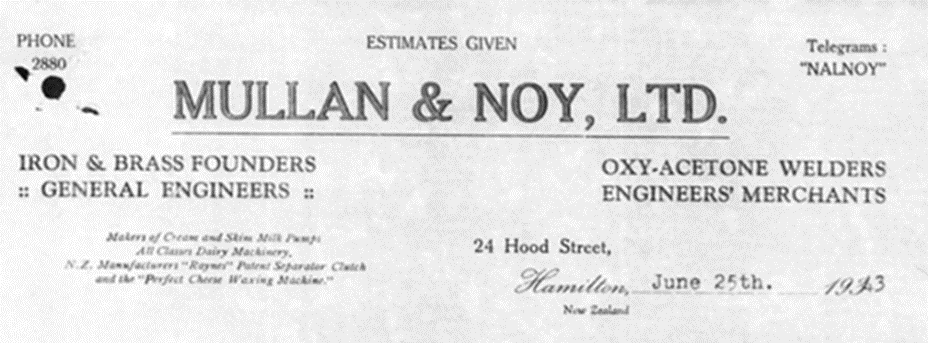
Edward (Ted) MULLAN 1887-1972 younger son of Thomas and Mary
Ted was born on 1 Nov 1887 at Grace Cottage, Newtown, Wellington. He attended school in Porirua,
and went on to Wellington College where he was on the prize-list for 1902. Ted became an engineer, following the example set by his father and older brother.
On 1 Jul 1916 at the residence of his sister (Mrs A Waters, Northland) Private Edward Mullan of the 17th reinforcements married Eva Lilian Baker, of Devonport. He saw service in France, and on discharge in 1919, was found no longer fit due to illness contracted on active service. On 10th April 1918 at Messines he was successful in getting a disabled gun into action which had been left behind, and was awarded the Military Medal for bravery, presented at sea en route for NZ.
His address in 1923 was
Tangowahine, Northern Wairoa, when his daughter Mollie was born at
Dargarville. She died aged 2 and is buried at Purewa cemetery Auckland
with her parents and grandparents. His eldest daughter Nada Patricia was
born in 1919 in the Auckland area. She married James Patrick McDevitt
and had at least one son. The third and youngest daughter, Judith
Llewellyn born in 1928, married Gordon Leslie Arthur Donaldson and
raised a family of three in Canada.
Thomas James MULLAN 1877-1918 eldest son of Robert Francis and Eliza
Thomas was born in Westport on 8 Jul 1877, and attended Nelson College 1891-1893.4 In 1899 the Westport School of Mines reported “one of the pupils, Mr T Mullan has left Westport to complete his scientific studies at the Technical Institute, Sydney.” Joan’s impression was that he then went to an engineering job in Hong Kong, and this is confirmed by a report in the Grey River Argus “We (Buller Miner) have been permitted to peruse a letter from Mr T Mullan dated Hong Kong, January 14, 1901, and are glad to state that he is well. . . .”
He came home in 1911 to supervise the construction of the Alexandra Building for his father, and married Laura Alice Franklin of Greymouth in 1912. Laura’s father being Mayor of Brunnerton, the wedding was an event in the district, with the local MP Sir Arthur Guinness proposing the toast to the bride’s parents. Unfortunately Laura developed TB so they tried fruit farming in Queensland, then returned to Hawkes Bay where they purchased another fruit farm. She died there in 1915 and is buried at Waipukurau, leaving an infant son Franklin (Lyn) Mullan born in 1912 in Queensland. Tom volunteered for war service in November 1915, (Private, New Zealand Machine Gun Battalion) leaving Lyn in Greymouth with Laura’s sister Kathleen. It was expected that Tom would marry her after the war. However, Tom died of pneumonia on 12 July 1918 in France, and was buried in Bagneux British Cemetery, Gezaincourt.
A report of Tom’s activity in Queensland was published in the Northern Advocate 8 Feb 1912:
Mr T. Mullan, son of Mr R. F. Mullan, of Westport, some time ago visited Queensland in connection with some contracts, and there became closely associated with several New Zealanders, all of whom had taken up land and were making a good business of it, principally in the growing of citrus fruits. Mr Mullan was so impressed with the country and its prospects that he decided to and finally did purchase a fruit farm for himself. It is situated within three miles of the port of Bowen, south of Townsville. Bowen has an admirable harbor, second only to Sydney, with 28ft of water at its jetty at low tide, and can accommodate with the greatest ease the largest boats visiting Australasia. Its development has lagged somewhat in the past, but under the progressive railway policy now being pursued by the Queensland Government, Bowen will have both an inland and a coastal connection. The coastal railway is costing £2,000,000 and is being constructed mainly by the immigrants, who are arriving in large shipments and being distributed over the country to the best advantage.
Franklin, known as Lyn, Tom and Laura’s only child, was cared for by her sister Kathleen who had been named as guardian when his father went off to war. Edith Kathleen Franklin would marry Harold Bradford Chalk in 1927, and so it was that Lyn was referred to as “nephew of Harold Chalk” in his wedding announcement. He married Marjorie Isobel Hull in 1937 in Liverpool, NSW, but the marriage ended in divorce in 1944. It is not known if there were children of this marriage, although the divorce papers, available in NSW archives 2323/1944, may answer that question.
Robert Francis MULLAN jnr 1878-1920 second son of Robert Francis and Eliza
Bob was born on 14 Sep 1878 in Westport. His is listed as Robert John Mullans in the online births index, the reason for changing his middle name is unknown. To distinguish himself from his father he always appended “junior” to his signature, which has led to the registration of his marriage being listed under the surname “Mullan Junior”.
Unlike his brothers, his name is not included among the old boys of Nelson College. He served in the Boer War 30 Sep 1899 - 9 Oct 1900 with Natal Royal Rifles and the Imperial Light Horse. These were English units, which recruited in New Zealand, quite separately from the New Zealand Contingent. The Grey River Argus reported on 5 June 1900 that “Mr R F Mullan, County Clerk has received from his son in South Africa one of the celebrated boxes of chocolates which the Queen sent to the soldiers in South Africa. The box, which is attractively got up, is painted red with a blue border, and on the left hand side are the letters “V.R.” with a crown on top, and on the right “South Africa, 1900” with the words “I wish you a happy New Year - Victoria” underneath.” I wonder who would have dared to eat the chocolates inside! Robert’s description on discharge was: character very good, age 23, height 5’10”, complexion dark, eyes grey, hair black, trade chemist. His South African medal has two bars: Relief of Ladysmith and Transvaal.
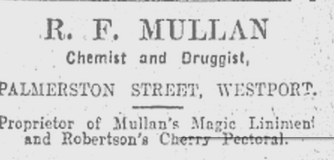
Bob qualified as a pharmaceutical chemist in 1902, and on 3rd August 1904 he married Madge Sinclair in St John’s Anglican church, Westport. They had two children, Joan 1905 and Don in 1908.
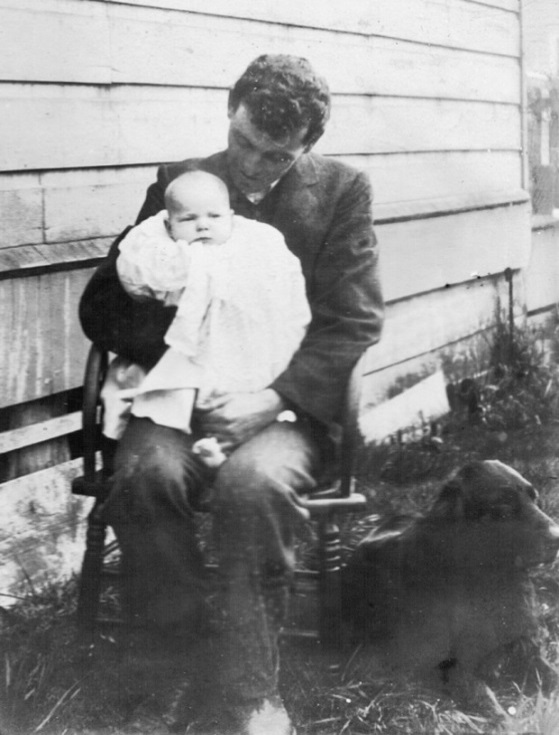
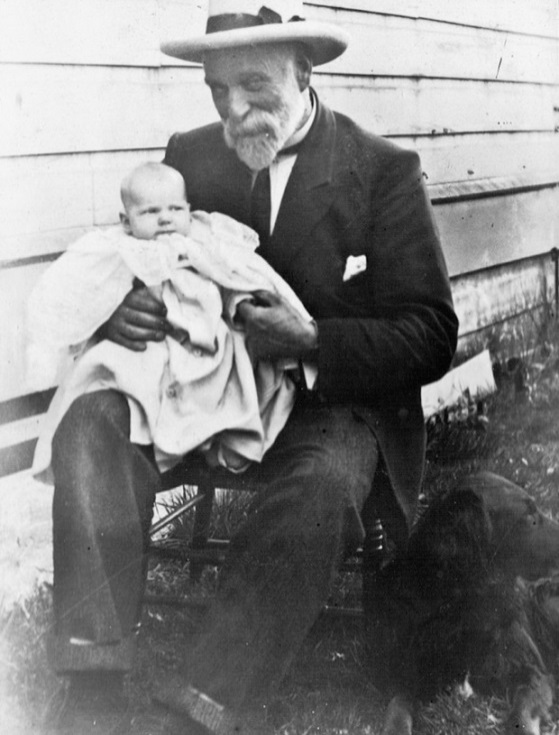
Baby Joan Mullan with her father Bob Mullan and with her grandfather George Sinclair
In 1911 their address was Pakington Street, Westport and it is likely that they occupied the second house built at the other end of Bob’s father’s large section which ran through from Russell Street to Queen Street. This house was rented out in later years.

House in Queen St Westport, cnr Pakington St, on far end of Mullan section
Then very suddenly on 4th
August 1920 Bob died of cervical cellulitis. This was an infection in
the neck area which gave rise to general blood poisoning, Joan said his
throat swelled so much that he could not take air into his lungs. After
her husband’s death Madge lived with her parents at “The Pines,”
and that would have been Joan and Don’s home base through their teenage
years. The Mullan’s only daughter Sissy having died in 1904, it fell to
Madge, their widowed daughter-in-law, to watch out for the elderly
Mullan couple as well as her own parents. Under her father’s will Madge
became the owner of The Pines in 1923 and lived there with her
mother until her own death in 1937.
12 Nov 1914 R F Mullan jnr elected to Westport Hospital Board
14 Nov 1914 Mrs R. F. Mullan, of Westport, is to be congratulated on the success of her patriotic song,"Britain’s Call to Britons All." which was set to music by Mr Grimat, of Melbourne, and published by a Melbourne firm. [Assume this was Madge, not her mother-in-law]
25 Jan 1916 A fire broke out in Westport on Sunday about 11.45 p.m. in the premises of Mrs Burns, occupied by R. F.Mullan, chemist, and quickly spread to the adjoining premises, owned and occupied by Mr Arthur Leaver, saddler. Both buildings were completely gutted, and the contents utterly destroyed. ……. The chemist's shop carried heavy stocks, valued at £2000 or over, and was insured, with the fittings, for £1700. Mr and Mrs Mullan left the shop at 9.15 pm and noticed nothing to indicate the presence of fire.
18 Dec 1918 Mrs R. F. Mullan is reported as seriously ill at Denniston where she has been nursing influenza patients. [Grey River Argus] Her daughter Joan recalled “November 1918 brought a week of rejoicing as nation after nation laid down its arms. There were cheering processions and dancing in the streets. But at the same time people were taken mysteriously ill. It struck very suddenly. It was called influenza but was different to flu we had known.”
Madge, with another volunteer, had been providing round the clock care to a Westport patient and was exhausted when Denniston was hit very badly. Many were afraid to answer the call for assistance so, although worn out, Madge went. There were many deaths and eventually Madge herself was struck down. The family were summoned to Denniston when her condition became perilous, but she pulled through and returned home at last, although too weak to walk and having lost all her hair.12
Obituary: “A sad and sudden death occurred at the Buller District Hospital shortly after mid-day on Wednesday [4 August 1920] when Mr Robert Mullan junr. passed away at the close of a very brief illness. The deceased was a qualified pharmaceutical chemist who first practised his profession with the late Ralph Robinson. On the demise of the latter, he opened business on his own account and successfully conducted same up till the time of his death. "Bob" was a genial jovial fellow with scores of friends who will regret exceedingly to hear of his death. His wife and two children along with other relatives will receive the condolences of a very wide circle of acquaintances as well as the sympathy of the entire community in their sad loss.”
The two children were Joan and Don, then aged 15 and 11. Joan won a junior free place for secondary school in 1919 and attended Nelson College for Girls. She later boarded at Bishopscourt in Christchurch while training at Christchurch Teachers’ College. Following a probationary teaching period at Murchison she was appointed to the sole charge school at Castlerock near Lumsden in Central Southland. Board was arranged with a family in Lumsden, but for transport she would need a car, a new model A Ford. She caught the eye of a local farmer and became Mrs Robert Hamilton Scott. Her story continues at page 25 in my Scott document
http://www.genealogy.ianskipworth.com/pdf/scottbook.pdf.
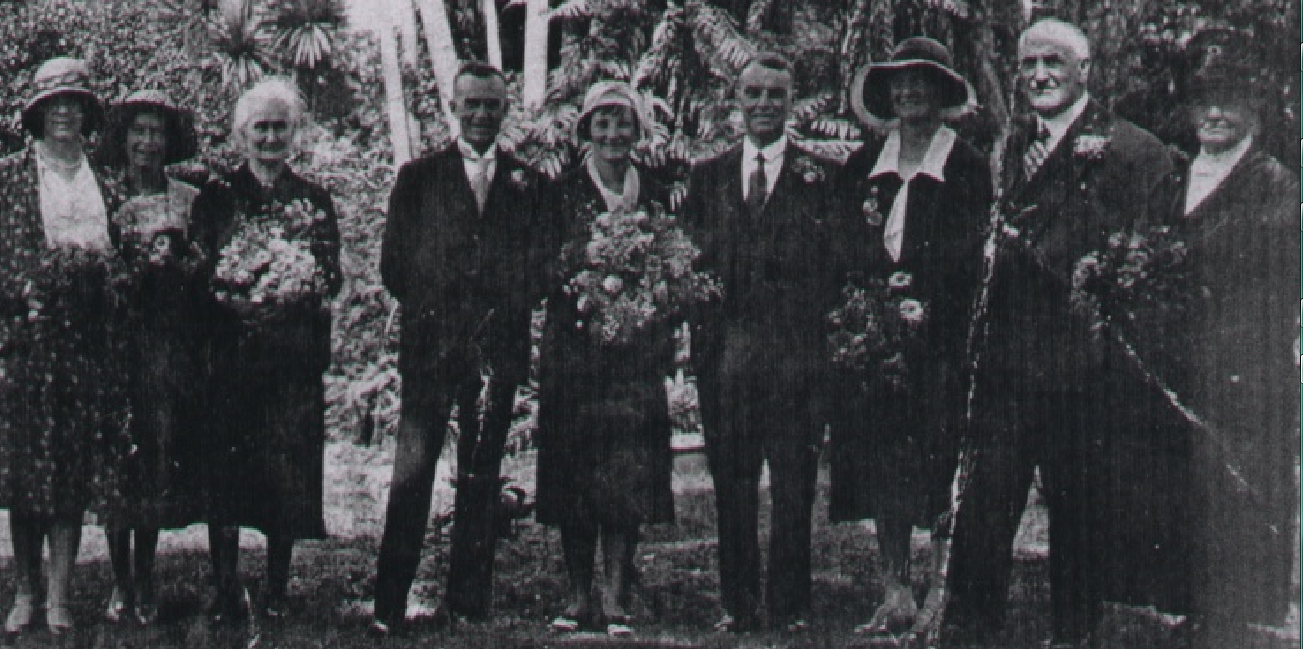
Wedding of Bob Scott to
Joan Mullan, The Pines, Westport: (from left) 2 bridesmaids,
Rebecca Sinclair (bride’s grandmother), Groom and Bride, Jack Mullan
(uncle), Madge Mullan (mother), possibly Ken Sinclair (Madge’s brother),
Eliza Mullan (bride’s grandmother)
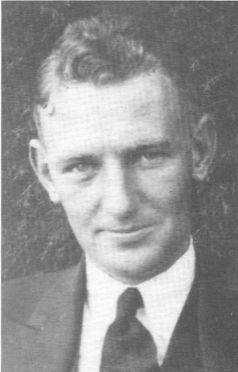
Bob Mullan’s only son, Donald Sinclair Mullan (1908-1983), completed his schooling at Westport High School with a Junior National Scholarship, and went to Wellington as a cadet in the Lands and Survey Dept.
He joined the Colonial Motor Company Ltd in 1930, as cashier, completed his Professional Accountancy examinations, and served on the CMC Audit Division, visiting dealerships through-out New Zealand in the early ‘30s when NZ roads could present quite a challenge. He was appointed manager of Timaru Motors Ltd in 1932 (aged 25), Managing Director in 1952, retiring in 1971. He became a director of Colonial Motor Co in 1962, retiring in 1973. [refer to biographical article page 26, also History of Colonial Motor Co18 ]
Elizabeth Susan (Sissy) SIEMER 1879-1904 only surviving daughter of Robert and Eliza MULLAN
She was born in Westport on 11 Nov 1879, listed as Lizzie Susan Mullans in the registration index, but known as Sissy. The story handed down was that she ran away with an artist and died in poor circumstances in the US. This was not entirely correct but may have been the cover story which suited her parents.
Public records show that Susan Elizabeth Mullan married Christian Emil Siemer (1874-1940) on 18 March 1903 in Wellington, New Zealand. Their daughter Olga was born three months later, and a son named for his father but known as Jim, the following year. Sadly Sissy died in Wellington shortly after her second confinement and Christian took the children to Adelaide to the care of his mother, Emilie Siemer. Grandma Emilie (1841-1937) was an interesting lady - a feminist well ahead of her time. For many years she was secretary of a Working Women’s Association and also worked hard for crippled children. At the age of 60 she studied English Literature and passed examinations at the University of Adelaide. She was a translator of German poetry, and the author of two published books. At 79 years of age she was learning the piano.
Christian’s paintings still command good prices. A Californian dealer provides this bio: Christian Siemer was a muralist and painter born in New Zealand** on November 22 1874. Siemer settled in Los Angeles in 1906 and remained a resident until his death. He is best remembered for a series of mural-sized canvasses of Los Angeles commissioned by the Chamber of Commerce to promote the area. An impressionist, his compositions generally contain architecture. He died on February 6, 1940. [**Incorrect, he was born and raised in South Australia.]
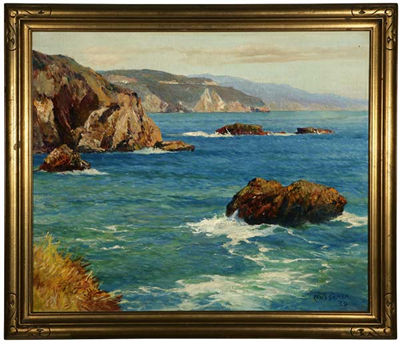
View of Malibou Coastline, California - Christian Siemer
Sissy is buried in Karori cemetery, Wellington (Area1 BlockA Row14 Plot38) with a large marble angel and the inscription: In loving memory of Elizabeth (Cissy) wife of C. Siemer entered into rest 12 Sep 1904 aged 24, beloved and only daughter of R.F. and E. Mullan, Westport. Deeply regretted. Sleep on dear Cissy and take thy rest, Lay down thy head upon thy Saviour's breast. We love thee well but Jesus loves thee best, Until we meet again, Good night. Thy will be done.
[The spelling “Cissy” used on her headstone casts doubt on how this nickname should be recorded. I have preferred to accept the spelling “Sissy” used by her husband in his US naturalisation application. It was probably coined by her brothers for their only sister.]
Sissy’s daughter Olga Valesca Siemer , was born on 4 June 1903 in Wellington, married Onias Charles Skinner and was listed with sons Bruce and Michael, aged 8 and 6 in the US census of 1940. She died in January 1987 in San Francisco, USA.
Sissy’s son Christian Emil Siemer, known as Jim, visited NZ in 1930. His cousin Joan wrote: “He drove the first car I ever owned with my mother [Madge] and myself from Westport to Southland via Lakes Pukaki and Tekapo, over the Crown Range to Queenstown, Lumsden and Bluff where he caught the Maheno back to Melbourne. He managed one of Sir Sidney Kidman's cattle runs. I have never heard of him since. His mother was never forgiven for eloping, but Grandma had him staying with her in the canopy covered best bed.”
Jim married Marion Georgina Sinclair at Broken Hill in 1935 and had several children. His name is associated with a number of stations in western NSW including Sturts Meadow (1934) Weiteringa (1937) Koonawarra (owner 1940s) Crystal Brook (Sth Australia 1950s). He is sometimes referred to as J or even James Siemer in the media due to his nickname Jim. He died in South Australia in 1992 aged 87, Marion having died the previous year.
John Robinson (Jack) Mullan 1883-1932 third son of Robert Francis and Eliza
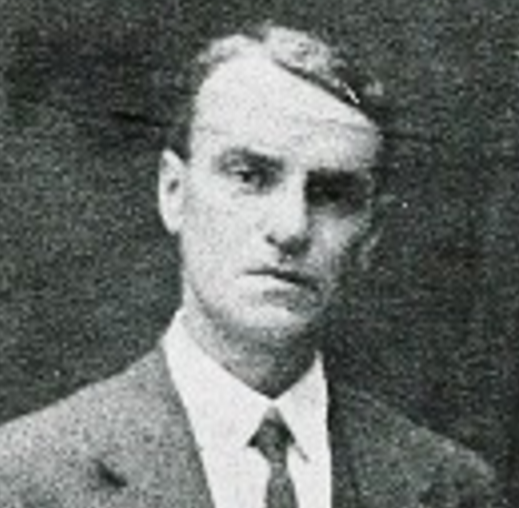
J R (Jack) Mullan 1926 County Clerk, Buller County Council.
(image courtesy KeteWestCoast
website)
Attended Nelson College 1898-1900 to which he won a 2 year scholarship, Gym Champion 1899, 1900.4 Numerous references to J Mullan appeared in the Grey River Argus around 1902 - 03, playing rugby, competing in swimming carnivals, singing at concerts. In 1901 he passed the Public Service examination, 1902 drafting cadet Railways Dept earning £30 pa, and in 1904 was employed in the Engineering Dept of the Railways at Greymouth. In 1905 he was transferred to Dunedin on promotion where he continued to compete in swimming championships. He took over from his father as clerk to the Buller County in 1910.
In 1913 he married a Westport girl, Isabel HUFTON, and having a child born in 1915 was not enlisted for war service until November 1917. From his record it appears that he was transported to England but did not serve in the front line in Europe. Jack died on 24 March 1932, aged 49, and his widow remarried Arthur Edmund MORLEY three months later.
His only daughter Molly Isabel Mullan (1915-1990) served as an Anglican missionary in India, and on her return to New Zealand was appointed principal of St Margaret’s College, Christchurch, a private Anglican boarding school for girls. The school website notes: In 1964, Miss Molly Mullan (MA) was appointed Principal and during her tenure the roll increased and the curriculum widened. It was she who established the Japanese department and appointed the first full-time Chaplain to the school. Miss Mullan is also remembered for her boundless energy, her outstanding administrative ability and her total involvement in every aspect of the life of the school.
Her name is also remembered in Mullan House (for girls) at Cathedral Grammar School, Christchurch. According to their website Miss Molly Mullan was warm and witty; an academic; a remarkable teacher, the first head of the school's Junior Department in the late 1930s and eventually the headmistress of St Margaret’s College; a tireless Christian missionary, Molly was the first woman Lay Canon to be appointed in New Zealand, and the first administrator of Christchurch Cathedral.
Obituary: Miss Molly Mullan, a former headmistress of St Margaret's College (1964-79) and lay canon of Christchurch Cathedral, has died in Christchurch aged 74.
Miss Mullan was born in Westport and educated at Nelson Girls' College. She obtained an honours degree in philosophy and education at Canterbury University College and graduated from Christchurch Teachers' College.
After three years teaching at the Waikato Diocesan School she was accepted by the Church Missionary Society for training in Melbourne. In 1947 she was sent to India, and until 1964 she was head-mistress of Bishop Azariah School for Girls in Vijayawada, in South India, and overseer of several hundred village schools. During her time there the school trebled in size and received national recognition.
She returned to New Zealand in 1964 to be headmistress at St Margaret's College. In her 15 years there the school grew, with a wide choice of subjects and courses and a renewed building programme.
In the mid 1970s she became a lay canon of Christchurch Cathedral, the first woman to be appointed to that position in New Zealand. When she retired from St Margaret's College her work at the Cathedral widened. She joined the staff as Cathedral Administrator and became a vice-president of the Friends of the Cathedral Association.
She was a board member of Te Wai Pounamu Maori Girls' College and Cathedral Grammar School where she was a part-time teacher from 1981 to 1989.
Miss Mullan's life of service touched many people in different lands in different ways.
Appendix 1: Will of Robert Mullan of Dungannon sourced from PRONI 1
I Robert Mullan of Dungannon in the County of Tyrone, Bridewell keeper, hereby revoke all wills and testamentary dispositions heretofore made by me, and declare this to be my last will and testament. I give devise and bequeath all and singular my property of what nature and kind soever, real and personal freehold and chattel of which I may be possessed or to which I may be entitled at the time of my death unto my friends George Moon and Robert Hancock, both of Dungannon aforesaid, and their heirs executors and administrators and assigns according to the nature of said property, upon the trusts and to and for the uses interests and purposes hereinafter declared of and concerning the same and I nominate and appoint the said George Moon and Robert Hancock to be the executors of this my will and the guardians of such of my children as are under the age of twenty one years.
I give to my wife Maria Mullan such articles of furniture and chattels as with the approbation of my Executors she shall select. I direct that the remainder of my personal effects shall be sold and that out of the proceeds thereof, and the remainder of my personal estate (including all monies which shall be payable for principal and bonuses from the Standard Insurance Company under a policy for assuring 300 pounds upon my own life which I hold from that company) all my simple contracts, debts and my personal and testamentary expenses shall first be paid and that such sum as my executors shall think fit shall be applied by them in assisting my son George to emigrate either to America or to one of the Australian colonies. I also direct that out of the same fund my Executors shall as soon as possible after my decease pay to Mr James Kyle of Cookstown the amount which shall be due to him for principal and interest upon his mortgage on my property in Coalisland. The remainder of the monies to arise from my personal estate I give and bequeath to my three daughters Matilda, Annabella and Susan, share and share alike, provided always that with respect to the share of my daughter Matilda it shall not be payable until 3 years after my death, and that with respect to the shares of my said daughters Annabella and Susan their respective shares are only to be paid to them upon their attaining the age of 21 years or marrying with the consent of their mother and of my said executors or of the survivor of them and in the event of either of my said 2 daughters Annabella and Susan dying before attaining the age of 21 years, or marrying without such consent while under age, then I direct that the share of her so dying or marrying shall be applied to the discharge of the mortgage held by the said Robert Hancock upon my property in Scotch Street Dungannon hereinafter mentioned and until my said daughters Annabella and Susan shall respectively attain the age aforesaid or do die under age as aforesaid I direct that their respective shares shall be invested in such measure as my executors shall think fit and the interest or dividends accruing to them thereon be applied to the maintenance and advancement in life of my said 2 daughters Annabella and Susan.
I give devise and bequeath to the said George Moon and Robert Hancock and to their heirs and assigns my two houses and premises in Scotch Street, Dungannon, and also my property in Coalisland all held by me in perpetuity, to hold the same for and during the life of my said wife Maria Mullan upon trust. In the first place, out of the rents issues and profits thereof to pay all head rents and other outgoings payable thereon including the annual interest payable to the said Robert Hancock on foot of his mortgage with which I hereby charge my said property in Scotch Street aforesaid, and afterwards to pay to my said wife such annual sum as together with such superannuation as may be granted to her by the Board of Superintendence of the County Prisons, will make up the sum of thirty pounds per annum. Out of the remainder of the said profit rents I direct that my said Trustees shall annually pay such further sums as they shall think fit to the maintenance, education and advancement in life of my son Robert and of my daughters Annabella and Susan, and should any residue remain after the several annual payments already mentioned I direct that same shall be from time to time during the life of my said wife invested according to the discretion of my said Trustees and the accumulations thereof at her death distributed between my three daughters in the same manner and upon the same conditions as is herebefore mentioned as to the residue of my personal estate bequeathed to them. Provided always that in case the said accumulations shall not be sufficient to make up the monies hereinbefore bequeathed to them respectively to the sum of one hundred pounds each, the deficiency shall be made up out of the rents and profits of my Coalisland and Scotch Street properties equally, and I make such deficiency if any a charge on my said properties to be paid as to one half thereof out of my Scotch Street property and one half out of my Coalisland property. From and after the death of my said wife I give and devise my property in Coalisland in the County of Tyrone above mentioned to my son Robert Mullan, his heirs and assigns forever, and with respect to my property in Scotch Street Dungannon I declare that upon and from the death of my said wife they my said Trustees shall stand seized and possessed of the said property upon trust for the use of my sons Thomas and George, their heirs and assigns for ever, share and share alike as servants in common and not as joint tenants. Inasmuch as I have been at great expense in educating my son William James for his profession, and in other ways, and consider that he has already got a fair share of my property I make no bequest to him in this my will. I hereby empower my said Trustees to sell and devise any of the before mentioned Trust property as they may deem expedient for the benefit of my children who may become entitled to the same, and that they shall not be accountable for any losses except such as shall be occasioned by their own wilful default. In witness whereof I have hereunto subscribed my name this twentieth day of January in the year of our Lord one thousand eight hundred and sixty six .......Signed Robert Mullan Proved 14th June 1866 - see probate book page 238.

Appendix 2: Thomas Mullan entry in Cyclopedia of NZ Vol 1 p353 1897 2
Mr Thomas Mullan, Inspector of Permanent Way for the Wellington and Manawatu Railway Company, has had a large experience in railway construction and maintenance. Born in 1841 in Dungannon, County Tyrone, Ireland, where also he was educated, Mr Mullan came out to the colonies at the age of fourteen. For some years he followed the diggings in Victoria, and ultimately entered the service as timekeeper on the Victorian railways at Woodend. He was again lured by “the gold fever,” and crossed over to Otago at the time of the rush to Switzer's. [1862] Later on, Mr Mullan went over the ranges to the West Coast goldfields. At Westport he joined the public service, and was engaged on surveys, and afterwards on the construction of the line to Waimangaroa. On the completion of this section he went to Marlborough, where he set off the line between Para and Blenheim stations. Mr Mullan was next engaged on the Central Railway between Hyde and Naseby, but left the Government service to work under Mr Higginson, who was constructing the Waimea Plains Railway. After a trip to Melbourne, Mr Mullan joined his brother in a contract on the Buller road, but left in June 1883, to assist Mr Higginson in the construction of the Wellington and Manawatu Railway. He first took charge of the Paremata bridge construction, and afterwards laid the permanent way between Pukerua and Waikanae. In 1886, Mr Mullan was promoted to the position now held by him. He is a member of the Masonic fraternity, though presently unattached. Having been initiated under the Scotch Constitution, he afterwards affiliated with the English, taking the Mark Master and Red Cross degrees. Mr Mullan was married in 1878 to Miss FitzGerald, of Melbourne, and has two daughters and two sons.
Appendix 3: Death record for George Mullan
Appendix 4: Sundry source items chiefly from Papers Past and Trove
Mr Thomas Mullan formerly connected with the construction works of the Westport railway, died at Auckland on Friday, aged 80 years. His brother, Mr R. F. Mullan, resides at Westport. Inangahua Times 14 Jan 1918
Mr. Thomas Mullan, late inspector Manawatu Railway Company, died at his residence, Wanganui-avenue, Auckland, on Friday last, aged 79. Mr. Mullan was a native of Dungannon, Ireland, and came out to Victoria, and subsequently to New Zealand, at the time of the goldfields rush on the West Coast. Some years later he removed to Wellington, and was an inspector of works during the construction of the Manawatu Railway line, on the completion of which undertaking he was appointed inspector of permanent way to the company. He retired on superannuation on the Government taking over the railway. The late Mr. Mullan, who was well known in Wellington, was a member of the Masonic body. He leaves a widow, two sons—Mr. T. Mullan (Auckland) and Mr. Edward Mullan (now on active service) —and two daughters—Mrs Alexander Nichol (Newtown), and Mrs. Athol Waters (Northland). Mr. Robert Mullan, of Westport, is a brother of the deceased. The interment took place at Auckland on Saturday.
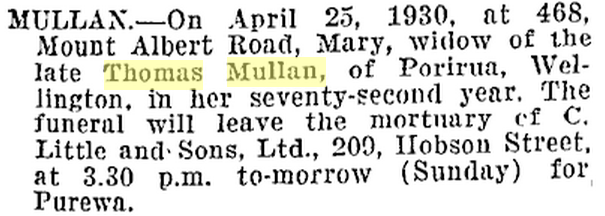
Auckland Star 26 Apr 1930

Evening Post 26 April 1930
ADELAIDE ARTIST SUCCEEDS ABROAD Drew Pictures When Three Years Old
Success has not come easily to Mr. Chris Siemer, a South Australian who has been appointed official artist to the Chamber of Commerce, Los Angeles (United States of America). As a young man, by dint of hard work he saved his fare to England. Having no money for tuition fees be hired a bicycle and rode from art gallery to art gallery in the country and the Continent, studying masterpieces. He then worked his way home to Australia.
The mother of Mr. Siemer is Mrs. Emilie Siemer, of Kenilworth road, Parkside. Speaking of her son, she said: "He was a born artist. At the age of three years we took him to a circus in Adelaide, and the next morning, found him excitedly drawing pictures of animals and other things he had seen. We called a doctor, who told us that Chris had convulsions. Throughout his childhood and youth we were careful not to cause further excitement by having him taught art, lest he should become ill. However, the artistic urge in Chris was not to be stifled. Mrs. Siemer possesses work executed by him as a youth. One picture is a fine watercolor copy done when he was about 14. Another is a large canvas measuring about three by six feet depicting a typical Australian country scene. A boy friend of Mr. Siemer was Mr. Septimus Power, who recently held an exhibition of work in Adelaide. Mrs. Siemer believes that each helped the other greatly in their apprenticeship to art. On leaving Pulteney Grammar School Mr. Siemer went to Western Australia when 22 years old, and did clerical work. Determined to succeed as an artist, however, he saved money and went abroad. For some years Mr. Siemer lived in New Zealand, where he married. His wife died after two years, and Mr Siemer brought his son and daughter to the care of his mother. In the meantime he worked hard at Sydney. A fire in his studio destroyed much or his best work, including a portrait of his wife, as well as Maori scenes. Proceeding to America, Mr. Siemer in 1913 was given an opportunity to express his talent in large-scale painting. California with its 270 odd miles of Grand Canyon, a mile deep and miles across, and its great wide spaces, offered fine possibilities to an artist. Mr. Siemer was asked to paint the scenery, the paintings to be exhibited throughout the United States of America to attract visitors to the place. Some of the paintings done by Mr.Siemer have been about three times his height and many feet long. A brother is Mr. B. O. Siemer, of Rosslyn Park.
[photo caption] SUCCESSFUL ADELAIDE ARTIST Mr. Chris Siemer, who has been appointed official artist to the Chamber of Commerce, Los Angeles. Mrs. Emilie Siemer, his mother, resides at Kenilworth road, Parkside. Adelaide News 29 July 1929
It is hereby notified for general information that the following persons have been elected, under the provisions of “The Goldfields Local Revenues Act, 1873," members of the Board for the respective district hereinafter specified, viz Buller District. George Dunn, Edward Ings, Philip M'Enroe John Mulligan, Robert Francis Mullan, John Munro. Alfred Greenfield, Provincial Secretary. Westport Times 11 Nov 1873
ALL NATIONS QUARTZ MINING COMPANY (No. 2 North), MOKIHINUI. NOTICE TO SHAREHOLDERS. Notice is hereby given that at a Meeting of Shareholders in the above, held at Westport on Monday, the 8th inst, a Call of twenty shillings per Share was made payable to the Treasurer, Mr F. M'Farlane, on or before Wednesday, the 17th inst., on which day a special meeting will be held at the Post Office Hotel, Westport, at 5 o'clock p.m., to consider the expediency of Registering the Company under the Mining Companies Act, at which all Shareholders are requested to attend, or send in proxies. R. F.MULLAN, Hon, Secretary. Westport Times 12 June 1874
16 Jan 1883 BULLER COUNTY COUNCIL. The ordinary quarterly meeting of the County Council commenced at 11 a.m. to-day. Present: The Chairman, Crs …………………..
Mr R. F. Mullans performed the duties of Clerk, vice Mr Dempsey, suspended. Inward Correspondence. From W. J Patterson, declining the office of Treasuer, and R.F. Mullan, accepting the same
That all salary due Mr Dempsey, late County Clerk, be retained until all deficiencies be made good Carried. Cr Brown moved to vote Mr Dempsey a quarter's salary. The voting was even, and the Chairman gave his casting vote against the motion. R. F. Mullan was temporarily appointed as County Clerk, at a salary of £3 per week applications, closing at next meeting, to be invited for the office, salary £156 per year. Westport Times 19 Jan 1883
6 March 1883 RFM described as “acting county clerk” in report of court proceedings.
Mr R. F. Mullan has received the appointment of Secretary to the Westport Building Society. Westport Times 28 Sept 1883
1903 Munro and Co., Ltd, are in receipt of a cable from London informing them that Hon A.J. Cadman has successfully placed the Waimangaroa coal lease in connection with his iron sand scheme. Everything is settled and the property will be taken over after inspection by the Company's engineer. The lease stands in the name of F. F. Munro and he has associated with him Dr M'Kenzie and R. F. Mullan. West Coast Times 4 Oct 1903
1910 WESTPORT, June 30. The Supreme Court sittings concluded to-day. In the case of Brosnahan v. R. F. Mullan and Co., Mr Justice Sim made an order for the dissolution of partnership as from to-day, the Registrar of the Court to take the accounts. His Honour disallowed a counter-claim for £454, also an application for appeal. Star 30 June 1910
1913: Mr R. F. Mullan, who for thirty-two years has acted as secretary to the Buller Hospital and Charitable Aid Board, has resigned the position, and will retire on twelve months' full pay. Evening Post 9 Dec 1913
Mr R. F. Mullan, County, Clerk for Buller county has sent in his resignation owing to advancing years and failing health. He had held the position for 27 years. He will get as a retiring allowance six months' full pay. Grey River Argus 29 Nov 1909
Mr R. F. Mullan,who yesterday resigned the office of secretary of the Buller Domain Board, owing to illness, also resigned that of secretary of the Westport Building Society, a position which he held for the past 47 years. Tributes were paid to his long conscientious and able services and the hope expressed that Mr Mullan would have a speedy recovery. Press 15 Jul 1927
Mr R. F. MULLAN (Press association telegram) WESTPORT, August 3. The death took place this evening of Mr Robert Francis Mullan. Born in Dungannon, County Armagh, Ireland, in 1847, deceased arrived in Queensland in 1867, later going to New South Wales. He came to New Zealand in 1870, and worked at mining at Giles Terrace, also in connexion with boating operations between Westport and Lyell diggings, and in contracting on the Buller road. In 1880 he was appointed clerk to the Buller County Council, which position he held until, through failing health, he retired in 1908. Other positions he held, were secretary of the Buller Hospital Board, Westport Domain Board, and Westport Permanent Building Society. He had three sons and two daughters, all of whom, except one son, John, who succeeded him as county clerk, predeceased him. One son was killed in France during the Great War, and another while serving in the South African War.** He is also survived by his widow. Deceased was a man of sterling qualities and of kindly, sympathetic, and charitable nature. His passing is deeply regretted. Press 4 August 1928
**Incorrect, son Robert who served in South Africa lived the rest of his life in Westport.
DEATH. On 17th July, 1915, at her residence, Waipukurau, Laura Alice, beloved wife of Thomas Mullan, and fourth daughter of Mr. and Mrs Thomas Franklin, Brunnerton, aged 30 years. Interment at Waipukurau to-day, Monday. Grey River Argus 19 Jul 1915
Donald Sinclair Mullan 1908-1983 – only son of Robert Francis Mullan jnr
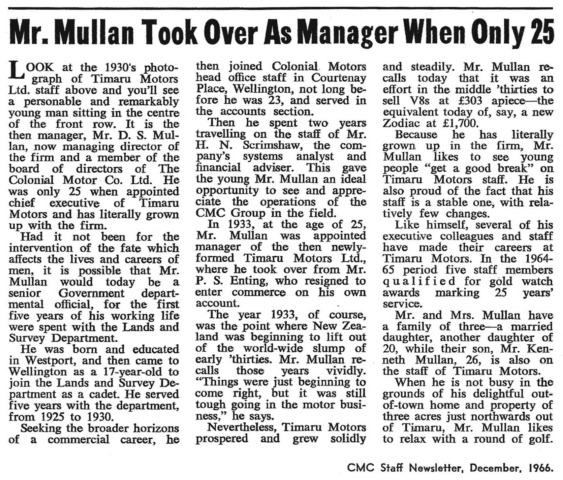
Sources
1. Public Record Office Northern Ireland (PRONI) wills image online - Robert Mullan 1866
2. Cyclopedia of NZ Volume 5. Nelson, Marlborough and Westland Provincial Districts. 1906
3. NSW marriage certificate 955/1876, NSW death transcription
4. Nelson College Old Boys’ Register 3rd ed. 1925
5. Personal recollections of Joan Manson, nee Mullan and of Molly Mullan
6. Papers Past New Zealand newspapers database – searched for Mullan
7. Trove Australian newspapers database – searched for Siemers
8. Appendices to Journals of House of Representatives NZ (A to Js) – searched for Mullan
9. British Newspaper Archive – searched for Mullan in Irish newspapers
10. Google Maps Street View – for images of former Mullan properties
11. Archives New Zealand for sundry Mullan wills, divorce files, military personnel files
12. The Spirit of Denniston Hill, Dai Hayward, 2004, page 82
13. Introduction to Ranfurly Papers, PRONI November 2007
14. Dungannon estate records, Lease & rental books, Family Search Films 258623-258636
15. Ordnance Survey Memoirs of Ireland v 20:… Mid & East Tyrone (copy Auckland Public Library)
16. A directory of Ulster doctors who qualified before 1901, Vol 2 R.S.J. Clarke (copy at APL)
17. The Royal Irish Constabulary – A complete alphabetical list 1816-1923 Jim Herlihy (copy APL)
18. Ford Ahead. A History of the Colonial Motor Company Ltd / Roger Gardner 2004
19. Robinson of Dungannon / Mary Skipworth http://www.genealogy.ianskipworth.com/pdf/robinson.pdf
20. Griffiths Valuation schedules and maps accessed at http://www.askaboutireland.ie/griffith-valuation/
21. Tithe Applotment Books searched at http://titheapplotmentbooks.nationalarchives.ie/
22. History of Wellington and Manawatu Railway Company, 1882-1908 / K R Cassells 1994
23. NZ Society Genealogists Kiwi Collection – searched for Mullan, especially school records
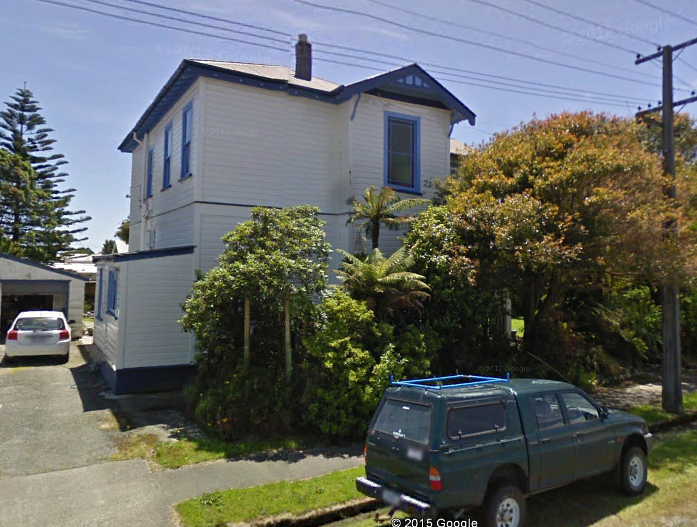
Sinclair home, The Pines, cnr Pakington and Romilly Sts, Westport in 2015Rear view from Pakington Street (partly demolished)